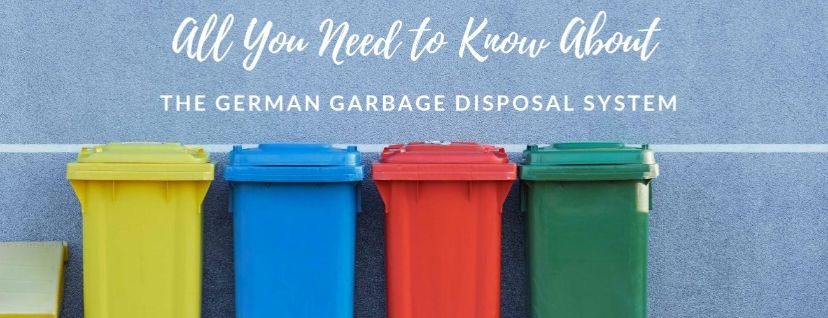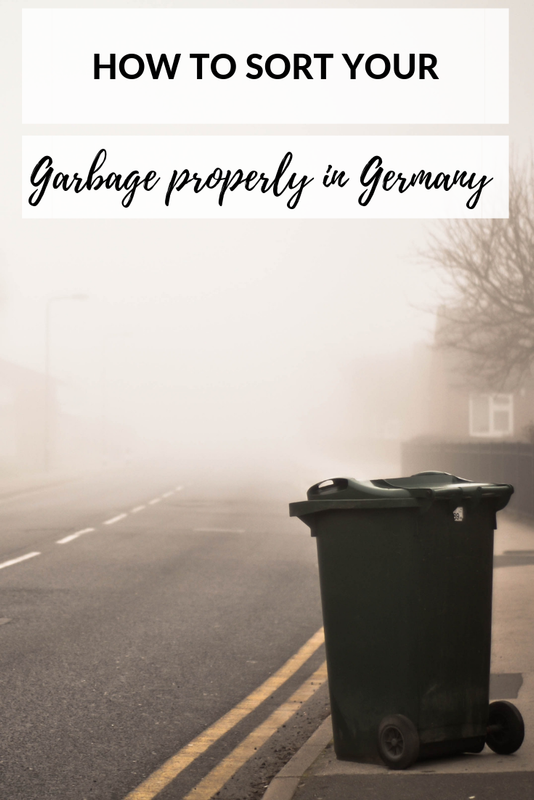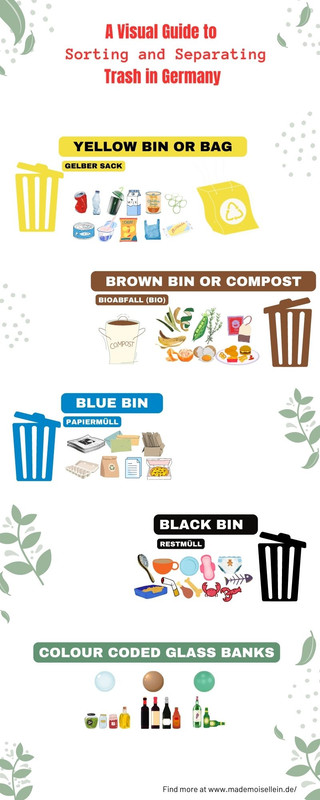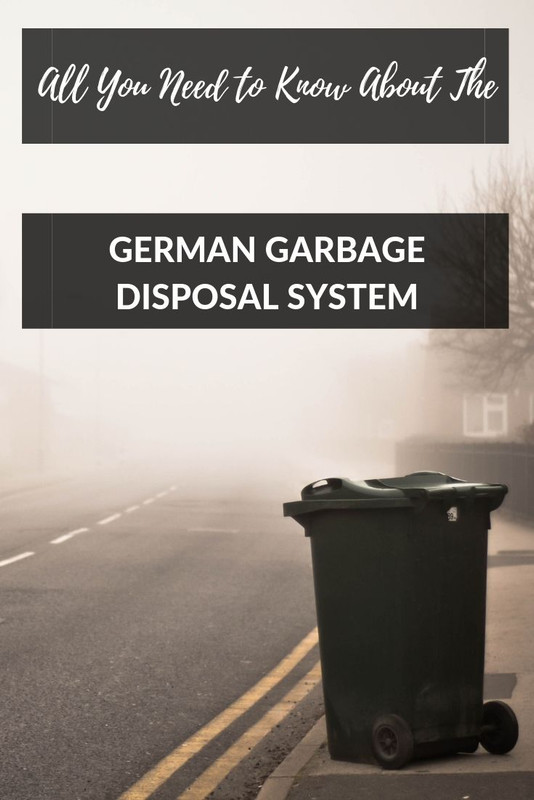
All You Need to Know About the German Garbage Disposal System
Top Takeaways From This Post
Last updated on January 6th, 2023 at 02:15 pm
So how would you rate your knowledge of the German mülltrennung system? Do you know how to properly separate trash in Germany? Learn all about German garbage disposal system in this article.
Many expats in Germany feel that the German garbage disposal system is just an unnecessary complication to an otherwise simple household chore.
Well, Germans would like to disagree with you. In fact, the German garbage disposal system is a matter of national pride.
At first, newcomers find it very hard to correctly sort garbage in Germany. But fret not, dear foreigners. This infamous German waste separation system is so complex that at times even the locals themselves cannot completely wrap their heads around it.
Here is a nifty guide to explain how the German garbage disposal system works. Go on, take up the challenge and become a Mülltrennung master in no time!
First, Some Important Factoids
The Green Dot (Der Grüne Punkt), a German dual system of waste collection and separation was introduced in 1991. The goal of this dual system is to keep recyclables as long as possible in an economic cycle by high-quality recycling. It is no wonder that Germany boasts the highest recycling rate in the world. The rate for municipal waste rose from 56% in 2002 to 67% in 2016. This goal was achieved so fast that Germany ended up reaching the 2020 target of increasing the recycling percentage for municipal waste four years earlier.
Germany’s waste management success really comes down to two factors:
- Strong government policies.
- German citizens being total bros and embracing recycling fully right from the start.
This is why it is also the responsibility of the expat community to make sure that our host country stays as clean and green as possible.
And now the lesson begins.
Overview of the German Waste Management System
Unlike in most countries, where localities have a trash bin and a recycling bin, there are multiple colour-coded recycling bins to sort garbage in Germany. This is where the infamous German efficiency truly shines.
In short, recycling starts at home!
By pre-sorting their recycling, the German government saves a significant amount of money, resources and time. This process also reduces the amount of cross-contamination that can potentially ruin entire batches of recycled material in Germany. This feat certainly wasn’t achieved overnight.
With time it became an inseparable habit in German households and, in fact, a matter of pride today.
Mülltrennung in Germany can be quite hard to master for fresh arrivals. So don’t be shocked if one day your nice German neighbour is suddenly schooling you over your garbage sorting skills. Take it as a lesson and learn from the experts. It happens to the best of us! 😉
How the German Garbage Disposal System Works
The big loop of separating trash in Germany begins at home. You sort the household waste as it comes, and later fill it into the different coloured bins in front or back of your house. It is then collected by the city council each week.
The Garbage Pick-Up Calendar in Germany
The trash bins in Germany are picked up on different dates in different municipalities. This pickup schedule is printed in a special calendar (Abfallkalender). You can find this schedule at the entrance of your apartment. If in doubt then you can ask your neighbours or Housemeister for more info.
You have to place your bins in front of your house the evening before the collecting date so that the collectors can empty the bins the following morning.
I know, I know! Separating trash in Germany sounds very complicated in the beginning. However, with a little routine, you will get used to it. And before you realise you will find yourself tearing off the clear plastic from your carton packaging and disposing of it in two different bins.
So now let’s take a look at the garbage bin colour codes in Germany.
How to Separate Trash in Germany
German garbage bins are colour coded; green, blue, yellow, brown and grey. You may notice that the colour of the bin itself may differ. So the colour of the lid is the key.
In most big to mid-sized cities, there are four different bins in almost every backyard. In the countryside, you may have to drive to a recycling plant to find these bins. Only certain types of waste may be thrown into each bin.
What goes in Yellow bin or bag (Gelb Sack/ Leichtverpackungen)
Light-weight product packaging, i.e. all packaging which are not made of glass or paper belongs in the yellow bin or bags. This includes:
- plastic packaging (yogurt tubs),
- tetra-pack (as for milk or juice),
- packaging with plastic in front and cardboard on the back,
- spray cans (empty deo or hairspray),
- boxes and tins,
- screw tops (used for marmalade glasses or milk or juice cartons caps),
- polystyrene,
- film and plastic bags,
- pet food packaging
In the absence of a yellow bin at your house building, you have to put plastic waste into a yellow plastic bag (Gelb Sack). This bag is then placed outside for collection at regularly scheduled times. These bags are available for free at your local Rathaus.
Pro tip: Don’t put non-recyclable waste into the yellow bags! Sometimes they are inspected by the garbage collectors. If there is something wrong with the sacks, the full bags will be returned for resorting with a big sticker on them. So sort your garbage properly and avoid the garbage sorting of shame in front of the entire neighbourhood.
What goes in Green or Blue bin (Papiermüll)
All packaging made of paper and cardboard, newspapers, magazines, waste paper, paper bags, pizza cartons, etc belong in the blue bins. If your packaging consists of paper and plastic parts, throw only the paper or carton of the packaging and not the plastic wrappers inside the box in the bin.
Don’t confuse juice and milk cartons/tetra-packs as paper waste. They go in the yellow sack/bin. If you don’t see a blue bin in your house building, you will find one around your neighbourhood.
Pro tip: Flatten the cardboard boxes before putting them in the bin. This way the bin won’t fill up too fast.
What goes in Brown Bin or Bio-Waste bin (Bioabfall)
Here goes all compostable kitchen and garden waste. This will include vegetable and fruit peel, vegetables, salads, eggshells, leftovers, small bones, fish bones, the leftovers of meat, bread and cake, coffee, tea bags, and rotten food (without packing!).
If you are lucky enough to own a house with a garden, then you can dump all of this into compost. Biological waste makes up almost half of the total garbage produced in Germany. In some areas of Germany, you can also dispose of cat poop in the organic waste bin.
Pro tip: You can also use biodegradable bin bags to safely dispose of your organic household waste.
What goes in Black or Grey bins (Restmüll)
This is where the rest of the waste goes to be incinerated. Garbage that does not fit in any of the above categories can be disposed of in the grey bins. Ash, cigarette butts, broken household objects like hairbrushes, light bulbs, porcelain, textiles and nylon stockings, socks, tissues, and other personal hygiene items, extremely dirty paper, vacuum cleaner bags, – you name it.
Pro tip: Women’s sanitary pads, tampons, babies diapers also go in black or grey bins in Germany.
What goes in Glass Waste bin (Behälterglas)
All those lovely empty wine bottles have to go somewhere as well.
German glass waste is also sorted by colour. There are different slots for depositing green, brown, and clear glass. You will find these bins dotted over every neighbourhood or near supermarkets like Edeka, Rewe or Kaufland. This includes wine bottles, jam/preserve jars, oil bottles, juice bottles, and even bath-salt bottles. Ceramics, china, mirrors, and wine corks do not belong in these bins.
Before dumping the bottles in the bins check them for a “Mehrweg” or “Pfand” symbol. If you see one, then you can take it back to a store like Edeka or Lidl and get a refund fee for them. Most beer bottles can be returned for a small pfand at any big superstore with an automatic collection machine.
Pro tip: Make sure that you do not dispose of bottles during the official quiet time (Ruhezeit). Sundays or late evenings are not the recommended times to chuck out your bottles unless you fancy a good ol’ stare down by the nearby Germans.
What goes in Hazardous Waste (Sondermüll)
At last, we are now left with “the rest”, i.e. the stuff that did not fit in any of the above bins. The German garbage disposal system has a plan for these leftovers as well!
Items like batteries and acids, cans with leftover paint, thinners, adhesives, corrosives, fluorescent tubes, and so forth, has to be treated as hazardous waste and disposed of separately by German authorities. Some examples of hazardous waste are as follows:
- Medicines
- Disinfectants
- Insecticides
- Electrical appliances
- empty batteries
- energy-saving light bulbs
- chemical cleaning agents
- spray cans, paint buckets, and paint residues
- empty printer cartridges
- waste oil
- substances with solvents
You will receive a notice from your local town council on when and where the truck collecting this kind of waste, will be. You need to bring your stuff to the site for them to dispose of it in the proper manner.
Pro tip: Do NOT add hazardous waste to the Restmüll. Otherwise, it will be incinerated along with the rest of the “grey” waste, and result in extremely poisonous gasses. Not good!
Where to dispose of sanitary pads in Germany
Women’s hygiene products e.g. sanitary pads, tampons, panty liners etc go in black or grey bins in Germany. Other similar products such as baby diapers, cotton buds, make-up remover pads and the like belong in the residual waste. It is best to put a small bin in your bathroom to dispose of personal hygiene items easily.
Where to dispose of electrical waste in Germany
Electrical and electronic equipment (EEE) should never be disposed of along with household waste in Germany. EEE waste contains several hazardous substances which, if exposed, could cause a detrimental effect on the environment, local wildlife and human health.
So how do you identify products that should not be disposed of along with household waste? Well, watch out for this with this icon:
If you’d like to dispose of electrical or electronic equipment for recycling, here is what you can do:
- If the items are still functional (and you just want to get rid of them) – Donate them to a local second-hand shop or a charitable organisation. In Germany, they are called Sozialkaufhäuser or Gebrauchtwarenhof.
- If they are beyond repair and not functional – Take them to a local recycling collection point run by your local authority. You want to look for a Recyclinghof or Wertstoffhof. Some cities also call them Abfallwirtschaftshof or Sortierschleife.
- Smaller EEE such as adapters or household batteries can also be dropped at the special EEE bins at your local grocery stores like Lidl, DM, Rewe, etc.
Where to dispose of cat poop in Germany
I could not find any official info on how to properly dispose of cat litter in Germany. To find out more about this, I scanned various cat-related German forums looking for an answer. The verdict seems to be that flushing it down the toilet is a BIG no-no!
However, you can put litter clumps in small dog poop bags and dispose of them in the Restmülle. If you don’t have a Restmülle, then the Biomülle is also acceptable.
If you are extra tolerant of cat poop stench, then feel free to just chuck it in your compost tub.
Pro tip: Use these biodegradable poop bags to safely dispose of cat poop in Biomülle. They are actually meant for dog owners but I have been successfully using them for my cat.

Where to dispose of cosmetics in Germany
Cosmetics could include (expired or otherwise) sunscreens, makeup, skincare products. If the product is in a plastic package, it will go into the yellow bin. If there is still some product inside the tube or tub, first empty it in the Restmüll. If it is a medical product, then you should follow the manufacturer’s instructions for proper disposal.
Pro tip: Nail paint remover counts as hazardous waste. it should be disposed of in Sondermüll.
Where to dispose of frying/ cooking oil in Germany
The larger quantities can be packaged in a sealed bottle and kitchen towel so that the waste bin is not soiled. Smaller quantities of frying fat or cooking oil can be disposed of in the Restmüll without any problems.
This is often burned later, with the oil serving as a useful fuel. However, it has no place in organic waste or compost, because the oil does not decompose.
Pro tip: You should not flush large quantities of frying fat or cooking oil down the kitchen sink or toilet under any circumstances.
Where to dispose of expired medicine in Germany
According to the Federal Ministry of Health (BMG), many medicines may simply be disposed of in the Restmüll. You can also check the packaging of the medicine, as sometimes they have a different requirement for disposal. Some pharmacies often accept waste medicines free of charge.
Where to dispose of old clothes or shoes in Germany
You can get rid of old clothing or shoes in Germany in a number of ways:
Sell them: Depending on their age or condition, you could consider selling them. Thrifting and second-hand clothing is becoming quite mainstream in Germany. You can choose from platforms such as Vinted, Momox or Mädchenflöhmarkt to sell your old clothes, handbags, or shoes in Germany.
Donate them: Donating old clothing is also a wonderful way to get rid of old clothes in Germany. You can donate them to a local second-hand shop or a charitable organisation. In Germany, these organisations are called Sozialkaufhäuser or Gebrauchtwarenhof.
Dispose of in a clothing bin: Altkleidersammlung or clothing bins are found everywhere in Germany. You can deposit pretty much any type of old clothing or shoes in an Altkleidersammlung.
Dispose of in Restmüll: If your clothes or shoes are completely damaged, you can also throw them in the black or grey bin.
Where to dispose of Christmas tree in Germany
If you have ever bought a real Christmas tree, you may have noticed that it sheds all over your living room like your long hair cat. But that is not the biggest issue with having a Christmas tree in Germany.
The real problem comes later. Once Christmas has come and gone you have to get rid of your once glorious tree. But how? You just cannot throw the tree in your bin in Germany. Well, the German garbage disposal system has covered all your bases.
There are two ways of disposing of your Christmas tree in Germany:
- A community Christmas tree pick-up date by your local authority. This date is often specified in the above-mentioned Abfallkalender of your town. You should remember to put your Christmas tree on the sidewalk in front of your house. This is a free-of-cost service by the city.
- A drop off (by you) at the local Christmas tree disposal area. You can also drop it off at the local Wertstoffhof or Kompostwerke. However, before dumping your tree check with them if you are at the right place.
- There is also a bonus third option! If your Christmas tree is 100% organic, then you can also donate it to a local house farm or zoo. Some animals such as horses, elephants, or camels love to play with them and nibble on the leaves.

Also Read: 45 signs you have been living in Germany for too long!
Fazit
I honestly never thought I’d be ever writing about waste management of any kind. Never mind the 2000+ words long guide about the German garbage disposal system! But here it is. 😉 It is truly worth educating ourselves about, and at times making fun of this super structured garbage sorting system.
Germany can be proud of itself for setting up a great example of running an effective and efficient waste management program. It is one thing to have a government policy but a whole other beast to have citizens proactively coming on board and dedicating themselves to making this recycling loop a success.
So here was your ultimate expats’ guide on how to sort garbage in Germany!
How would you rate your knowledge of the German mülltrennung system? Do you sort your garbage in Germany according to the system? Do you think anyone who masters the German garbage disposal system should be automatically granted the German citizenship? 😉 Tell us in the comments below.
Read more about German expat life here.













9 Comments
Sarah
Hello!
Any idea where to dispose of expired sunscreen?
Valentina
Hi, quick question. What if I have many garbage bags that dont all fit in the grey bin (just moved in, have a lot of trash). Will they accept multiple garbage *bags* next to the grey bin??
Yamini
No idea sorry, never experienced this personally. But I don’t see why they won’t pick the bags next to a clearly ‘full’ garbage bin.
Aditi
Hi! This is a great blog, thanks for making everything easier! I still have a an answered question though, what do I do with my cats tree that he has scratched to its end 😄 it has to be disposed…
Yamini
Hah Thank you very much! 🙂 What is the material – is it wood and Sisal coil? If yes, then maybe Restmüll?
BTW, sometimes the brands also have this info on the packaging or the website, might be worth looking into 🙂
Yusra Sabar
Hi there. thank you for your interesting blog which I enjoy reading. Perhaps we want to do similiar exercises in our country Malaysia.
good article!!!
Ash
I have forgot to keep the rest müll for the disposal. Ascot is happening for the first time, I don’t know where to dump it. Instead waiting for another 15 days, where I can dispose?
Yamini
Hello Ash, Can you please rephrase your question? I’m not sure I understand it correctly.
Pingback: